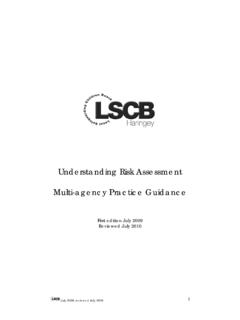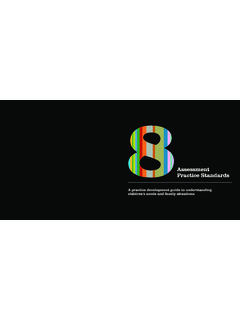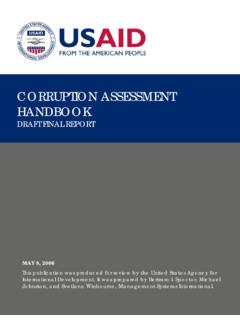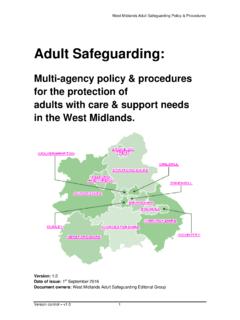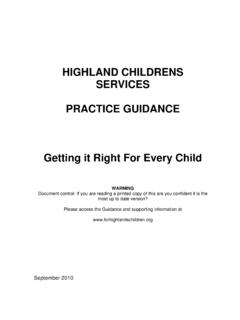Transcription of NATO Code of Best Practice (COBP) for C2 Assessment
1 NATO Code of Best Practice (COBP) for C2 Assessment Presented by Valdur Pille Metrics and Experimentation Group Systems of Systems Section Defence R&D Canada Valcartier With Dr R Hayes Ms C Wallshein EBR Inc US AFSAA. PR3-1. Form Approved Report Documentation Page OMB No. 0704-0188. Public reporting burden for the collection of information is estimated to average 1 hour per response, including the time for reviewing instructions, searching existing data sources, gathering and maintaining the data needed, and completing and reviewing the collection of information. Send comments regarding this burden estimate or any other aspect of this collection of information, including suggestions for reducing this burden, to Washington Headquarters Services, Directorate for Information Operations and Reports, 1215 Jefferson Davis Highway, Suite 1204, Arlington VA 22202-4302.
2 Respondents should be aware that notwithstanding any other provision of law, no person shall be subject to a penalty for failing to comply with a collection of information if it does not display a currently valid OMB control number. 1. REPORT DATE 2. REPORT TYPE 3. DATES COVERED. 00 DEC 2003 N/A - 4. TITLE AND SUBTITLE 5a. CONTRACT NUMBER. Measures of Merit (MoM) 5b. GRANT NUMBER. 5c. PROGRAM ELEMENT NUMBER. 6. AUTHOR(S) 5d. PROJECT NUMBER. 5e. TASK NUMBER. 5f. WORK UNIT NUMBER. 7. PERFORMING ORGANIZATION NAME(S) AND ADDRESS(ES) 8. PERFORMING ORGANIZATION. REPORT NUMBER. DREV/DND 2459 boul Pie XI North Val Belair Quebec G3J 1X5 Canada 9.
3 SPONSORING/MONITORING AGENCY NAME(S) AND ADDRESS(ES) 10. SPONSOR/MONITOR'S ACRONYM(S). 11. SPONSOR/MONITOR'S REPORT. NUMBER(S). 12. DISTRIBUTION/AVAILABILITY STATEMENT. Approved for public release, distribution unlimited 13. SUPPLEMENTARY NOTES. See also ADM001657., The original document contains color images. 14. ABSTRACT. 15. SUBJECT TERMS. 16. SECURITY CLASSIFICATION OF: 17. LIMITATION OF 18. NUMBER 19a. NAME OF. ABSTRACT OF PAGES RESPONSIBLE PERSON. a. REPORT b. ABSTRACT c. THIS PAGE. UU 28. unclassified unclassified unclassified Standard Form 298 (Rev. 8-98). Prescribed by ANSI Std Z39-18. It's best to know what you are looking for, before you look for it.
4 Winnie the Pooh, from Milne PR3-2. Overview Background Objectives Definitions Characteristics, Reliability, Validity Categories, Examples OOTW Normality Indicators Collaboration Metrics Uncertainties Framework - Practical Issues Challenges / Issues Recommendations Conclusions PR3-3. Context STRUCTURAL. RELATIONSHIPS. 3 Problem OF CODE SECTIONS. Formulation Key features: Sponsor Non-linear Problem 4 Iterative Solution Strategy 6 Human &. Organisational Issues 5 Measures of 7 Scenarios Merit (MoM. (MoM)). 8 Models & Tools 11 Products 9 Data 10 Assess Risk Underlined numbers (3) refer to chapters of the COBP. Shaded box indicates the current chapter PR3-4.
5 Background Cost PR3-5. Objectives of Assessment Comparison of alternate systems or solutions replacement systems or components determination of most cost-effective approaches Assessment in new or unexpected applications Establishment of standards, bounds of performance Identification of potential weaknesses Analysis of effectiveness of training Evaluation of effectiveness of human decision making Assistance in requirements generation and validation PR3-6. MoM Definitions DP - Dimensional Parameters Properties or characteristics in physical entities MoP - Measures of Performance Measures of attributes of internal system behaviour MoCE - Measures of C2 Effectiveness Measures impact of C2 systems MoFE - Measures of Force Effectiveness Measures of how a force meets mission objectives MoPE Measures of Policy Effectiveness PR3-7.
6 MoM Hierarchy Environment Force C2 Systems C2 Subsystems Element DP MoP MoCE MoFE MoPE. PR3-8. MoM Hierarchy Environment Force C2 Systems C2 Subsystems MoFE MoP DP MoCE MoPE. Element PR3-9. Linked MoMs MoPE1 MoPE2. MoFE1 MoFE2 MoFE3. MoCE1 MoCE2 MoCE3 MoCE4 MoCE5. MoP1 MoP2 MoP3 MoP4 MoP5 MoP6. DP1 DP2 DP3 DP4 DP5 DP6 DP7 DP8 DP8 DP9 DP10. PR3-10. MoM Tendencies MoM Focus Scenario Effort Number Impact Compre- Generaliz- Required hension ability MoPE Outcome Dependent High Few High Policy Low MoFE Mission MoCE C3I. MoP Systems DP Process Independent Low Many Limited Technical High PR3-11. Characteristics of Measures (1).
7 Reliability accuracy of a measurement: variance of repeated measurements of the same phenomenon must be known or estimated to discriminate between real effects and measurement effects PR3-12. Characteristics of Measures (2). Validity internal: causal relationship between variables construct: measure objective, and only objective statistical conclusion: results are robust with sufficient sensitivity external: extent to which results could be generalized expert: degree accepted by experts in the field PR3-13. Levels of Evaluation Goals (mission objectives) - Environment Functions and sub functions Tasks Structure / Interfaces Physical Entities PR3-14.
8 Example HQ MoMs - Levels Network of headquarters Single headquarters Cells within the HQ. Specific tasks within cells PR3-15. Example HQ MoMs Monitoring and understanding Information transmission, values, times, effect, comprehension Planning Information exchange, co-ordination, impact, flexibility, process quality Directing and disseminating PR3-16. Categories of Performance Measures Time based time to perform a task rate of performing tasks time to react to events Accuracy based precision of performance reliability of performance completeness error rates quality of decisions PR3-17. Collaboration Metrics Averages of understanding among team members Extent of alignment of these understandings Maximum level of understanding within team Gaps in understanding throughout team PR3-18.
9 Normality Indicators Relative measures State of normalcy Characterize an element of the civil environment Data collected on a regular basis Assessment of the changes occurring in the civilian populace PR3-19. Normality Indicators Criterion Examples Political Elections, political participation Economic Unemployment, interest rates, and market baskets Social Number of students in schools, number of refugees Technological Telephone system availability Legal Judicial system functioning Environmental Roads, water supply, power supply Cultural Sports events, concerts PR3-20. Limitations of Normality Indicators Inexperienced personnel Limited resources, constraints Effect of military presence Require data to be calibrated against baselines Extrapolation across space and time Shifting emphasis, thresholds PR3-21.
10 Effects of Uncertainty Study assumptions uncertainties in scenario, model input Modelling assumptions Uncertainties in the model, structural uncertainty Model sensitivity Uncertainties in the outcome PR3-22. Summary : Framework Establish evaluation environment Define evaluation goals State context, assumptions, constraints Define domain MoPE, MoFE, MoCE, MoP, DP. Identify specific measures Establish scenario or stimulus Establish data collection means Pilot test, revise measures and procedures Conduct the tests, debrief and analyze PR3-23. Challenges / Issues Linkage of DP-MoP-MoCE-MoFE. Interpretation of measures Environmental components Reliability and validity Uncertainties - scenario, model, outcomes Human-in-the-loop Cost and convenience Modelling PR3-24.










